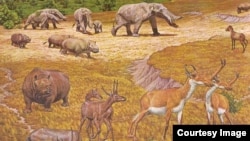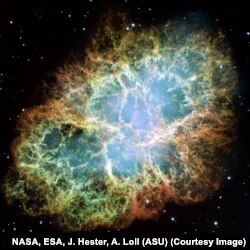Scientists know that two massive stars exploded about 300 light years from Earth less than 10 million years ago. Both explosions - the first between 8.7 and 6.5 million years ago, and the second about 3 million years later - happened during the age of large mammals - mastodons, ground sloths, bears, and the ancestors of humans. During this time, the Earth was going through major geological and environmental changes. There were even some minor extinctions.
Scientists have long wondered if those two explosions played a role in any of these terrestrial changes. Physicist Brian Thomas of Washburn University in Kansas modeled the effects of the supernova to try to find out.
A cosmic shower
A supernova is the explosive death of a massive star. These interstellar bombs don’t just spew visible light in all directions. They also emit high-energy light such as gamma rays and more massive particles, known as cosmic rays. These pieces of cosmic shrapnel can do damage to planetary atmospheres and lifeforms too close to the action.
Since nothing travels faster than light, Thomas and his colleagues first looked what would happen when the light output from the blast reached Earth. Luckily for the lifeforms during this time, the dangerous gamma rays were relatively weak. But the visible light was equivalent to the brightness of the full moon and remained so for a few weeks.
“Based on the research on light pollution,” Thomas explains to VOA, “we found that the amount of light we would get from the supernova would probably be enough to have a small effect but not a dramatic effect.” The extra light pollution possibly disrupted the sleep or hunting patterns of nocturnal animals for a brief period.
Not far behind the light came the cosmic rays. Since these particles are more massive, they can penetrate the ground and water pretty easily. They generate radioactive particles as they enter the atmosphere. The dose of radiation from this cosmic fallout would have been equivalent to the dose delivered by a single CT scan. So Thomas says the biological effects, if any, would have been minor.
The most significant effect occurred in the atmosphere. The cosmic rays would have increased the electrical charge of the lower atmosphere. It’s similar to when you drag your feet on the carpet and a static charge builds up. This extra charge needs somewhere to go, so you touch a metal doorknob, creating a spark. The only place the atmosphere has to discharge is the ground below.
So, lightning strikes would have increased significantly over a period of 20,000 years. Thomas isn’t sure what effects this would have on the environment or climate. That is going to be addressed in future work.
Environmental effects
While Thomas’ group is planning to look into the environmental effects, VOA decided to ask some paleontologists about it.
Edward Davis, a fossil curator at the University of Oregon, says that while the paper, published in Astrophysical Journal Letters, presents an interesting idea, “they’re trying to piggyback their event on top of an established environmental change and it’s not clear to me that there is a gap that needs to be filled by an additional causality.”
During the period when the radiation and light from the supernova would have reached Earth, there were global environmental changes. The Earth went from being mostly covered in ice to having periodic ice ages, when the ice sheets would recede and expand regularly. The planet's land masses were also rearranging themselves. Paleontologists find that the minor marine extinctions during this time were more likely due to the changing currents.
Smithsonian Institute paleontologist Richard Bambach has worked with physicists to model global changes due to astrophysical phenomena. His major concern is that the timescales on which these supernova effects occur are much too short to be seen in the fossil record. So paleontologists have no way of confirming Thomas' proposed effects.
Both Davis and Bambach say that the extra “light pollution” wouldn’t have been more than a minor annoyance for animals. And increased lightning strikes and the radiation levels would have very little impact on the species or environment, compared to the geological changes already occurring.
Paleontologists who study this time period don't need supernova to explain the extinctions or climate change. And this research proves it.
Let’s keep talking about extinctions
However, Davis says this work is important for other reasons. It gets people talking about what causes species to become extinct, and this is particularly important right now.
With or without the supernova, Davis notes that the extinctions during this ancient era are small compared with the extinctions that scientists are documenting now. So just bringing attention to this time period and the climate changes that occurred gets people thinking about the relationship between climate change and extinction.
“If we can get people talking about extinction," he adds optimistically, "that’s good.”






